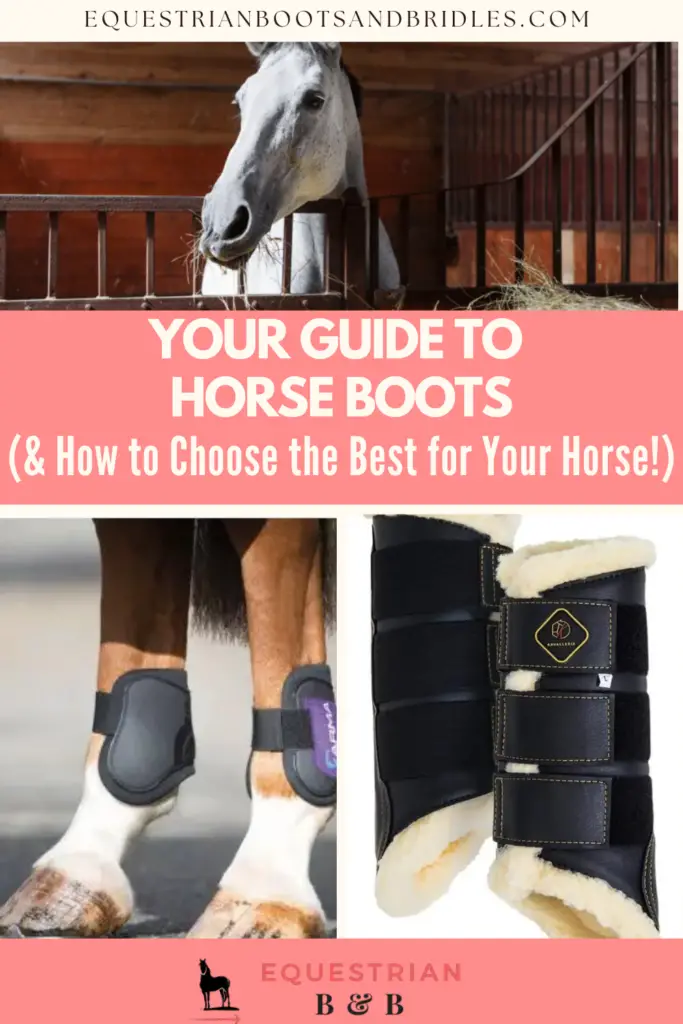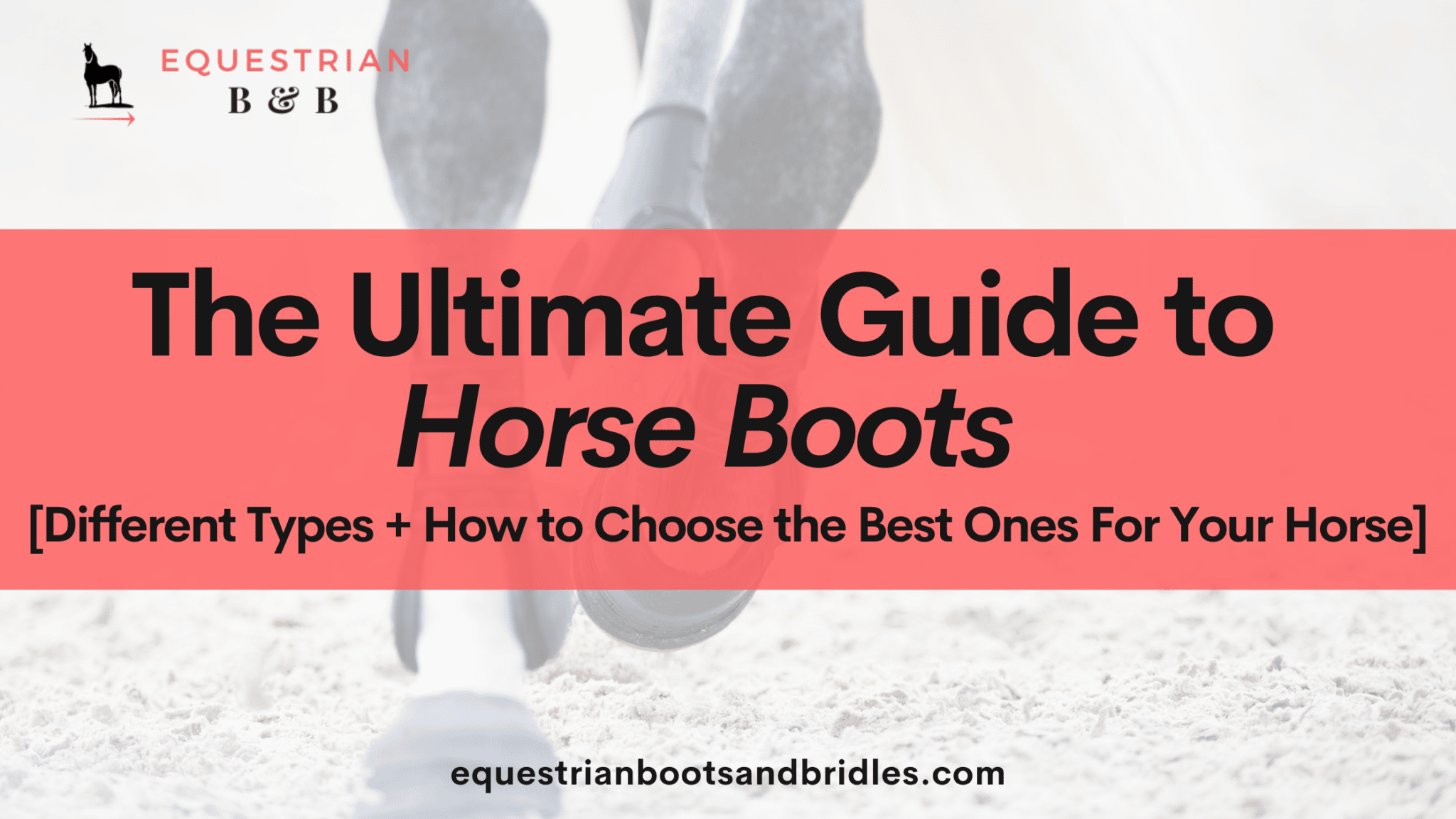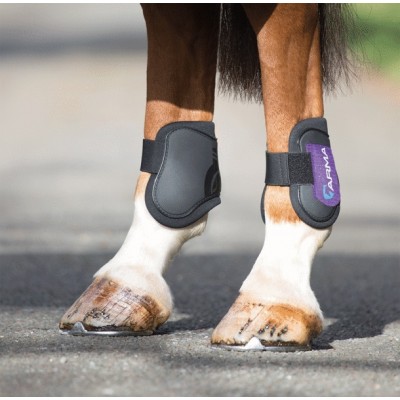Horse boots come in all shapes, colors, sizes, designs, and purposes, but they all have one goal: to protect your horse’s lower legs.
The activities we ask our horses to engage in can sometimes lead to minor or major injuries from a bad step or overexertion. But turnout time can also lead to rough housing, exploring areas of the pasture with hazards, or simply cause sores from lying on rough patches of dirt or gravel.
It’s enough to make a horse owner wish for a giant sheet of horse-shaped bubble wrap to keep their horses from injuring themselves!
Boots for horses’ legs are the next best solution, since it’s not possible to put your horse in bubble wrap to protect them. Usually the type of boot you use is dependent on the type of equestrian discipline you ride, but many boots are considered to be all-purpose and work well for any type of riding activity.
On the other hand, if you’re working at the higher levels of riding, such as show jumping or performing advanced dressage movements, you’ll want a technical boot to provide superior support and protection.
As you look at the types of boots for horses on the market, take into consideration their construction, materials used, and the coverage they provide. You want a boot that protects the fetlock joint (at the very least), won’t twist, and is easily secured to the leg.
Another thing to consider is that horse boots are going to get dirty, so you’ll need to know how the boots should be cleaned and dried to maintain their shape and prevent damage.
The following is a guide to the different types of boots for horses, and what you should consider before buying a pair for your horse.
This article contains affiliate links, which means we may earn a commission if you decide to make a purchase.
A Brief Look at the Anatomy of a Horse’s Lower Leg
Before you can choose the best boots for your horse, you’ll need to have a basic knowledge of horse leg anatomy.
The lower leg of the horse consists of bone, tendons, ligaments and little else. The ligaments and tendons reach down from the knee to the back of the hoof and deep inside of it to connect to the coffin bone (the bottom-most bone of the leg, which is within the horse’s hoof). In short, a horse is a miracle of nature that something so large can stand on such a fragile structure!
Protecting the tendons and ligaments of the lower leg is vital to keeping a horse sound during its working career. Keeping the tendons and ligaments in good working order through the use of slow warm-ups and polo wraps works well, but some disciplines require boots for horses that are more aggressive in their support and protection.
Conformation (or the shape & structure of the horse) plays another role in the movement of a horse at all gaits and during a movement such as jumping or dressage. A horse that is narrow at the base or close in at the feet and knees is one that’s more likely to interfere with itself as it moves. A horse with turned out feet may suffer lameness with frequency due to the strain put onto their tendons from poor conformation.
There are a number of issues that can affect a horse’s way of moving. Their conformation can make it difficult to move in some directions without interference, and other minor conformation issues can turn into a bigger problem when asking them to perform movements or jumps.
A horse with conformation issues that is otherwise capable of performing its movement will benefit greatly from the use of a boot to protect them from self-injury and damage over the long term.
In these cases and others, horse boots can go a long way towards helping a horse overcome their conformational issues, recover from a previous injury, and be less prone to injury going forward.
The Different Types of Horse Boots
Here are the different types of boots that horses will wear, and their various purposes. Below you’ll also find links to more comprehensive recommendation guides for each type.
Brush Boots
Brush boots, also known as brushing boots, are full coverage boots that protects the horse’s legs from another leg brushing against it. (Hence the name brush or brushing boots!)
They feature a splint pad on the inside of the leg that protects the leg from impact and close to the outside of the leg to prevent a stray hoof from opening up the closures.
As a general rule, brush boots are intended to provide light protection and support. You’ll see them used at the hunter level for going over jumps and during flat work, on the trails, and any equine activity that requires a little leg protection.
Some brush boot manufacturers make them in a heavy-duty version with thick padding and high-impact resistant shells, but if your horse needs that level of protection, you might want to consider a horse boot made for high-intensity activity.
To check out our favorite brushing boots, click here.
Tendon Boots
Tendon boots get their name from their open front, which allows a horse to feel a bump against a pole or obstacle. The idea behind the boot is to remind the horse to pick their legs up higher when going over a jump, but not become shy about a jump or become injured. This is why tendon boots are most often used for jumping.
However, the tendon boot isn’t solely used for this purpose, as the open front lets air flow through and keeps the legs cool during their performance.
These boots come in different configurations that range. For example, some involve a hard outer shell with a soft, cushioned liner and minimal closures to keep the boot in place. Others use a partial hard shell in the rear and use the lining as an extension to cushion the straps while offering more airflow.
They also use elastic and Velcro straps for a firm fit that doesn’t bind and allows for movement. Some boots use a hook and stud strap connector to let the straps move up and down without losing tension.
Tendon boots range in protective strength from average to aggressive. The average boot strength is good for most hunter/jumper riding, while the aggressive strength is suitable for high jumping at speed. Lighter, non-technical tendon boots work well for schooling and low jumps.
For our recommendations on the best tendon boots, click here.
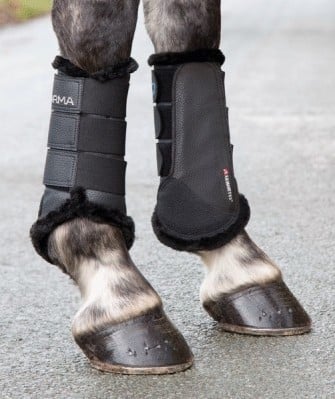
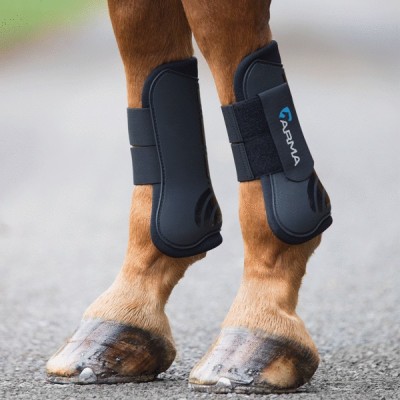
Jumping Boots
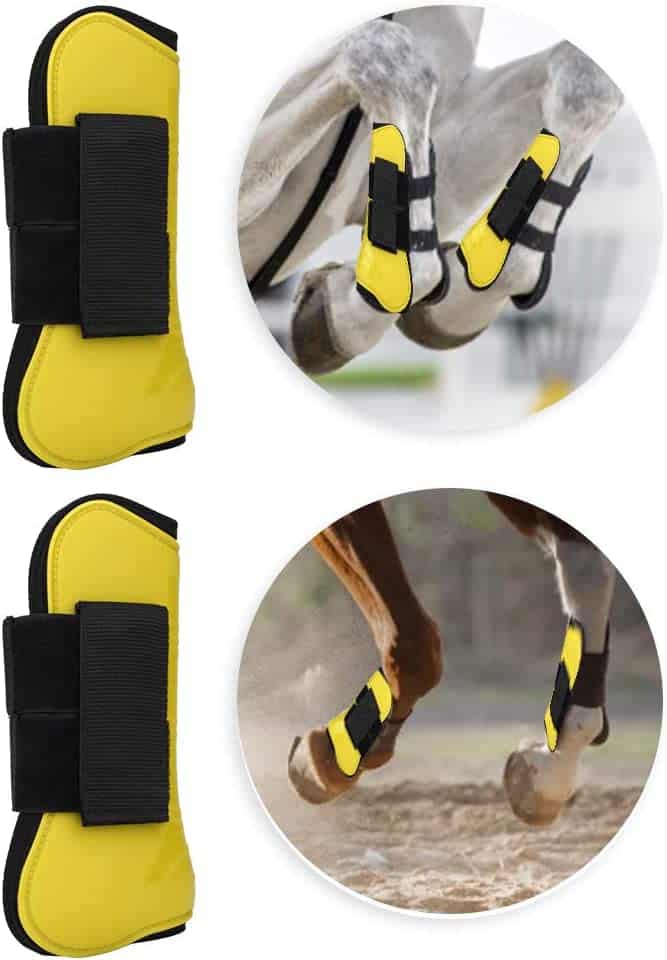
A horse that’s taking higher jumps repeatedly experiences heavy loading on its tendons as it leaps and lands. Over time, a horse can experience tendon injuries if it’s not properly protected and supported with boots. Jump boots for horses are designed to deliver heavy-duty support to the tendons, help them recoil back into place and stretch without overextension.
Jump boots come in configurations that are similar to tendon boots and are always open-fronted for the same reason tendon boots are. They use similar materials and construction, but tend to be stronger to provide optimal support and protection.
The best types of jump boots are ones with hard shells to protect against knocks from all directions, yet let the horse feel the impact without pain, and have features that minimize heat while delivering airflow.
Check out this guide for our recommendations on jumping boots.
Dressage Boots
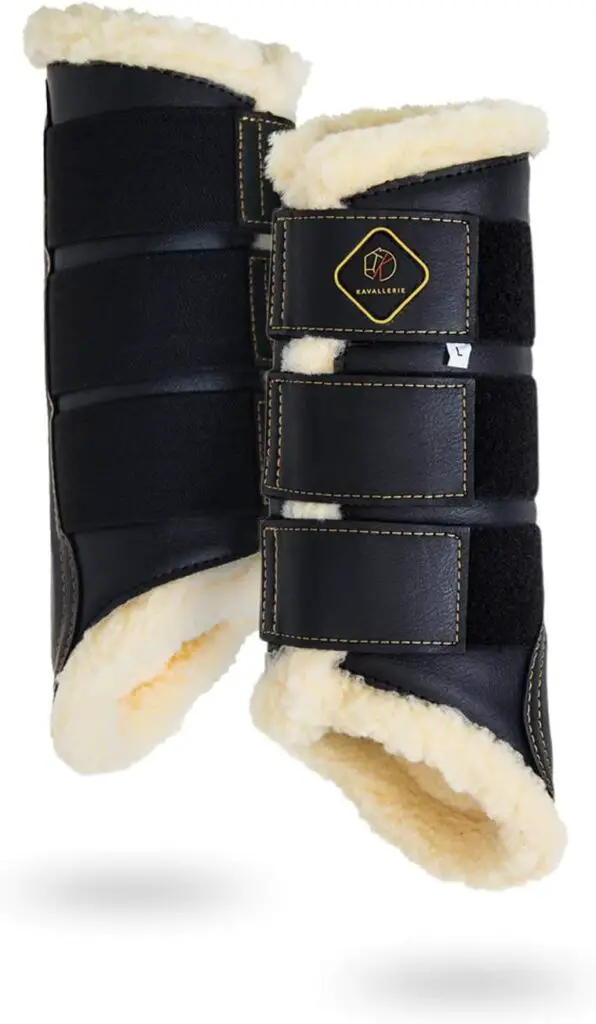
Dressage tends to put less strain on the lower legs than other disciplines, but it strains them all the same. However, a dressage boot doesn’t have to provide a lot of support in comparison to a jump boot. A good dressage boot keeps the tendons warm, dry, and supple as the horse is working, features a strike plate that can withstand interference, and conforms nicely to the leg.
The key to buying a dressage boot is finding one that provides tendon support and ventilation to reduce heat build-up. For horses working at the upper levels, a boot with an exterior shell provides enough support and aids the horse in performing their extensions and tight movements without strain.
It never hurts to have different types of strengths of dressage boots handy for those days when you’re hacking out or going for an intense training session. Having the proper protection handy helps to protect and preserve your horse’s lower legs.
Here is our guide to the best dressage boots for horses.
Bell Boots
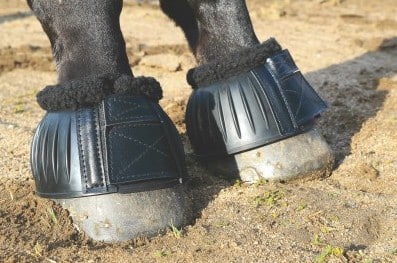
Bell boots protect the pastern and hoof from the rear hooves in the event the horse is prone to overreaching or is engaging in a high-speed activity. A horse working at speed is at risk of grabbing their front legs with their rears as they push to perform their pattern at speed. This can result in the horse taking out a chunk from its heel bulb, or injuring its pastern or fetlock. The bell boot acts as a barrier between the hoof and joint, preventing injury.
Bell boots come in multiple designs that range from the basic upside-down ribbed cup shape made from rubber to an ergonomic cushion made from ballistic nylon and neoprene that wraps around the hoof and closes in the front. The bell boot also features a collar that protects the coronet band from impact.
A traditional rubber bell boot features ribbing that keeps the boot from flipping up and also adds a layer of protection from a strike. However, the rubber boot provides the least amount of protection and is best used for turnout or light work. Padded bell boots provide more strike protection and are more durable than rubber bell boots.
The see our recommendations for the best bell boots, click here.
Fetlock Boots
Fetlock boots are used primarily on the rear legs of the horse during training and competition. These are a type of horse boots that cover the inside of the fetlock joint and protect it from a strike from a front leg or if a horse tends to open up its hocks when going over a jump. Fetlock boots also protect the joint from a knock against a pole.
Fetlock boots are made using different materials for differing levels of protection. Full neoprene boots provide the least amount of protection, while a boot with a hard shell and fleece lining provide the maximum amount of shock absorption, protection, and comfort.
The type of fetlock boot you pick usually correlates to the activity you’re engaging in, but the stronger boots work for everyday wear, while softer boots are intended for low-level activity and impact.
The see our recommendations for the best fetlock boots, click here.
Turnout Boots
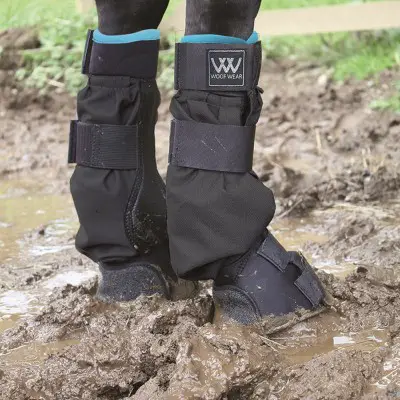
The turnout boot is about the next best thing you can get to bubble wrap for your horse. They cover a variety of needs that range from fly protection to mud fever prevention. Turnout boots are purpose-made, which means the boot you use is the boot that provides the protection you seek.
You may want to use a fetlock ring to protect a sore, fly boots on all fours to prevent flies from landing and irritating the horse, or mud fever boots that prevent mud from reaching the fetlock joint and start an infection or scratch.
You may find that you wind up owning a variety of turnout boots for different uses at different times of the year, and that’s good for your horse. Having multiple types of turnout boots means you are prepared for just about any kind of protection your horse needs.
Check out our recommendations for the best turnout boots here.
Like this post? Save it on Pinterest. Follow me on Pinterest.
